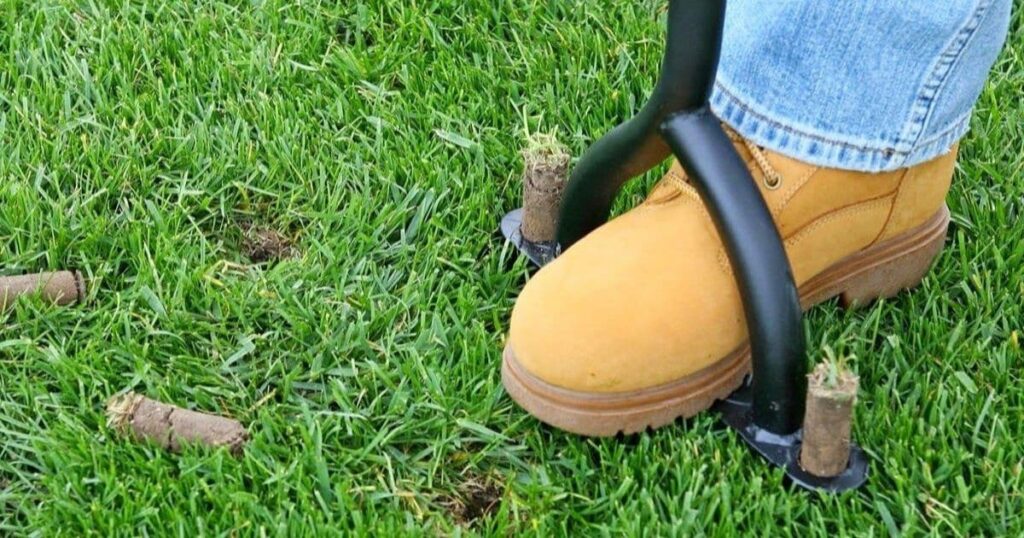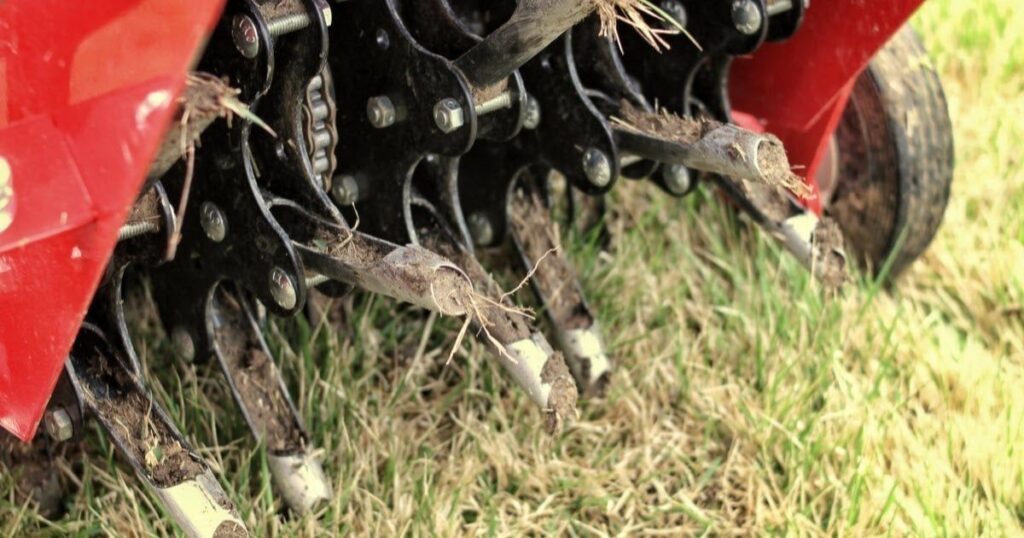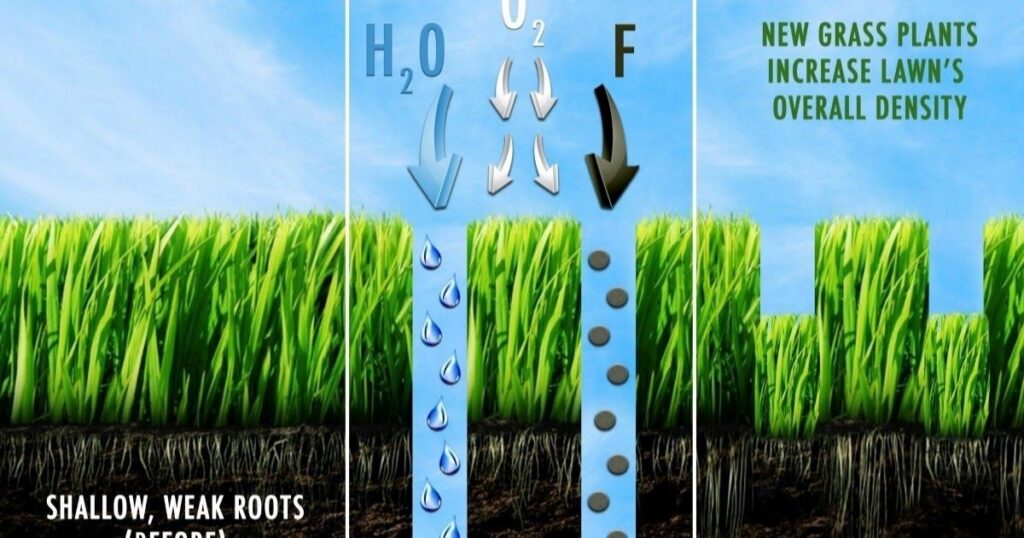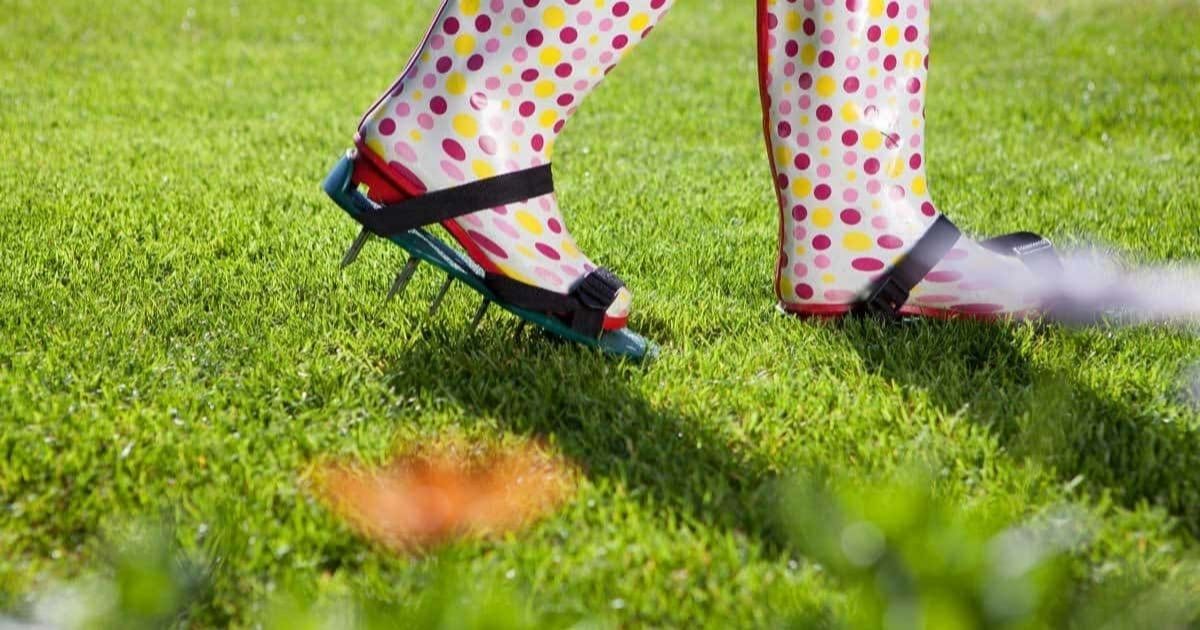Maintaining a lush, green lawn is a goal for many homeowners, but achieving that perfect turf requires more than just regular mowing and watering. One crucial aspect of lawn care that often goes overlooked is lawn aeration. This essential practice can make a significant difference in the health and appearance of your grass. In this comprehensive guide, we’ll explore what lawn aeration is, why it’s important when to do it, and how to perform this vital lawn care task.
What is lawn aeration?
Lawn aeration is a crucial grass maintenance technique that involves creating small holes in the soil to allow air, water, and nutrients to penetrate the grass roots more effectively. This process helps alleviate soil compaction and promotes better air circulation within the lawn ecosystem.
The primary goal of aeration is to improve the overall health of your lawn by
- Reducing soil compaction
- Enhancing nutrient intake
- Improving air circulation
- Breaking down the layers
- Promoting stronger root growth
By introducing these small openings in the soil, lawn aeration facilitates gaseous exchange, allowing oxygen to reach the roots while helping to release carbon dioxide. This process is essential for maintaining a healthy lawn and promoting robust grass growth.
Why do you need to aerate your lawn?

Aeration is a vital lawn care practice that offers numerous benefits for your grass and soil. Here are some compelling reasons why you should consider aerating your lawn:
- Alleviates soil compaction: Over time, foot traffic, lawn mowing, and other activities can lead to compact soil. Aeration helps loosen the soil, allowing roots to grow more freely.
- Improves nutrient absorption: By creating pathways for air, water, and nutrients to reach the root zone, aeration enhances the lawn’s ability to absorb essential elements for growth.
- Reduces thatch buildup: A thick thatch layer can prevent water and nutrients from reaching the soil. Aeration helps break down this layer, improving overall lawn health.
- Enhances water infiltration: Aerated lawns allow water to penetrate deeper into the soil, promoting drought resistance and reducing water runoff.
- Stimulates root growth: By reducing soil compaction and improving nutrient intake, aeration encourages stronger, deeper root systems.
- Increases disease resistance: A well-aerated lawn is more resistant to common lawn diseases and pests due to improved overall health.
- Improves lawn color: Proper aeration can lead to a more vibrant, uniform grass color by enhancing nutrient absorption and overall lawn health.
By incorporating regular aeration into your lawn care routine, you can significantly improve the health and appearance of your grass, resulting in a lush, green lawn that’s the envy of the neighborhood.
When is the best time to aerate a lawn?
Timing is crucial when it comes to lawn aeration. The best time to aerate your lawn depends on various factors, including grass type, climate, and soil conditions. Generally, it’s recommended to aerate during the growing season when the grass can heal and fill in any open areas after the soil plugs are removed.
For cool-season grasses (e.g., Kentucky bluegrass, fescue, ryegrass):
- Early spring (March to May)
- Early fall (September to November)
For warm-season grasses (e.g., Bermuda grass, zoysia, St. Augustine):
- Late spring to early summer (May to July)
It’s important to note that you should never aerate a dormant lawn, as this can cause unnecessary stress and damage to the grass.
Also read this post: best times of day for optimal results.
Seasonal lawn aeration schedules to choose from
To help you plan your lawn aeration schedule, consider the following options based on your region and grass type:
- Spring aeration: Ideal for cool-season grasses, spring aeration helps prepare your lawn for the growing season. Aim to aerate when the soil is moist but not waterlogged.
- Fall aeration: Another excellent time for cool-season grasses, fall aeration helps prepare your lawn for winter and promotes strong root growth in the spring.
- Summer aeration: Best for warm-season grasses, summer aeration should be done when the grass is actively growing and can quickly recover from the process.
- Bi-annual aeration: For heavily used lawns or those with severe compaction issues, consider aerating twice a year – once in spring and once in fall.
When and how often to spike a lawn depending on its type
The frequency of lawn aeration depends on various factors, including soil type, grass variety, and lawn usage. Here are some general guidelines:
- New lawns: Aerate once a year for the first few years to promote strong root establishment.
- Clay or compacted soils: Aerate 1-2 times per year to improve drainage and reduce compaction.
- Sandy soils: Aerate every 2-3 years, as these soils are less prone to compaction.
- High-traffic areas: Aerate 1-2 times per year to alleviate compaction from frequent use.
- Healthy, established lawns: Aerate every 2-3 years to maintain good soil structure and grass health.
Remember to adjust your aeration schedule based on your lawn’s specific needs and conditions.
Need a professional?
If you’re unsure about aerating your lawn yourself or simply don’t have the time, consider hiring a professional lawn care service. Professional aeration ensures that the job is done correctly and efficiently, using the right equipment and techniques for your specific lawn type and conditions.
When choosing a professional service, look for:
- Experience and expertise in lawn aeration
- Positive customer reviews and testimonials
- Proper licensing and insurance
- Competitive pricing and transparent quotes
A professional can assess your lawn’s needs and recommend the best aeration schedule and additional lawn care practices to keep your grass healthy and vibrant.
How to aerate your lawn

If you decide to aerate your lawn yourself, follow these steps for the best results:
- Prepare the lawn: Mow the grass to a slightly shorter height than usual and remove any debris.
- Water the lawn: Moisten the soil 1-2 days before aeration to make the process easier and more effective. The soil should be moist but not waterlogged.
- Mark obstacles: Identify and mark sprinkler heads, shallow utility lines, and other obstacles to avoid damaging them during aeration.
- Choose your aeration method: Decide between spike aeration (poking holes) or core aeration (removing soil plugs). Core aeration is generally more effective for reducing soil compaction.
- Aerate the lawn: Make multiple passes over the most compacted areas, ensuring consistent coverage across the lawn.
- Leave soil plugs: If using a core aerator, leave the soil plugs on the lawn to decompose and return nutrients to the soil.
- Water and fertilize: After aeration, water the lawn thoroughly and apply a balanced fertilizer to promote recovery and growth.
- Continue regular maintenance: Resume normal lawn care practices, including mowing and watering, to support healthy grass growth.
Remember to focus on high-traffic areas and spots where water tends to pool, as these are likely to benefit most from aeration.
Can a garden fork be used to aerate a lawn as well?
While a garden fork can be used to create holes in your lawn, it’s not the most effective tool for proper lawn aeration. Here’s why:
- Limited depth: Garden forks typically don’t penetrate the soil deeply enough to provide significant aeration benefits.
- Soil compaction: Using a garden fork can increase soil compaction around the holes, counteracting the purpose of aeration.
- Inefficiency: Manually aerating a large lawn with a garden fork is time-consuming and labor-intensive.
- Inconsistent results: It’s challenging to maintain consistent hole depth and spacing when using a garden fork.
For small areas or spot treatments, a garden fork can provide some aeration benefits. However, for comprehensive lawn aeration, it’s best to use proper aeration equipment such as a core aerator or spike aerator.
How do you know if your lawn needs aeration?

Several signs indicate that your lawn may benefit from aeration:
- Compacted soil: If your soil feels hard and water pools on the surface, it may be compacted.
- Thatch buildup: A thatch layer thicker than 1/2 inch can prevent water and nutrients from reaching the soil.
- Thinning grass: Areas of sparse or patchy grass growth may indicate compaction issues.
- Poor water absorption: If water runs off instead of soaking into the soil, aeration can help improve absorption.
- Discolored or stressed grass: Yellowing or brown patches may indicate poor nutrient uptake due to compaction.
- Heavy clay soil: Clay soils are prone to compaction and benefit from regular aeration.
- High-traffic areas: Lawns with frequent foot traffic or vehicle use are more likely to need aeration.
- Recently constructed lawns: New lawns built on compacted subsoil often require aeration to improve root growth.
If you notice any of these signs, consider aerating your lawn to improve its health and appearance.
What tools will you need to aerate a lawn?
Several types of lawn aeration equipment are available, each with its advantages:
- Manual core aerators: These hand-operated tools remove small plugs of soil and are suitable for small lawns or spot treatments.
- Spike aerators: These tools create holes in the soil without removing plugs. They’re less effective than core aerators but can be useful for light aeration.
- Hollow tine aerators: These machines remove soil cores and are ideal for larger lawns or severe compaction issues.
- Lawn aerator shoes: These spiked sandals attach to your shoes and aerate the lawn as you walk. They’re best for small areas or light maintenance.
- Pull-behind aerators: These attachments can be pulled behind a lawn tractor or ATV and are suitable for large lawns.
- Power aerators: These gas-powered machines are highly efficient and ideal for large or heavily compact lawns.
Choose the tool that best fits your lawn size, soil conditions, and personal preferences.
Read more about lawn care
To maintain a healthy, vibrant lawn, it’s essential to combine aeration with other lawn care practices. Consider exploring these related topics to enhance your lawn care knowledge:
- Proper mowing techniques and frequency
- Efficient watering methods and schedules
- Fertilization tips and timing
- Weed control strategies
- Overseeding and lawn renovation
- Soil testing and pH management
- Natural lawn care practices
- Seasonal lawn maintenance tips
By implementing a comprehensive lawn care routine that includes regular aeration, you’ll be well on your way to achieving the lush, green lawn you’ve always wanted.
In conclusion, lawn aeration is a crucial practice for maintaining a healthy, vibrant lawn. By understanding the importance of aeration, knowing when and how to perform it, and combining it with other essential lawn care practices, you can significantly improve your lawn’s health, appearance, and resilience. Whether you choose to aerate your lawn yourself or hire a professional, regular aeration will contribute to a beautiful, thriving lawn that you can enjoy year-round.
FAQs
How and when to aerate your lawn?
Aerate your lawn during the growing season, typically in spring or fall for cool-season grasses and late spring to early summer for warm-season grasses. Use a core aerator or spike aerator to create small holes in the soil, focusing on compacted areas and making multiple passes for best results.
What is the purpose of aerating a lawn?
The primary purpose of aerating a lawn is to alleviate soil compaction and improve air, water, and nutrient penetration to the grassroots. This process helps promote healthier grass growth, enhances root development, and improves the overall health and appearance of the lawn.
How is aeration done?
Aeration is typically done using specialized equipment such as a core aerator, which removes small plugs of soil from the lawn, or a spike aerator, which creates holes without removing soil. The process involves systematically covering the lawn area, and creating holes that allow better air, water, and nutrient circulation in the soil.
Why is aeration important in the grass?
Aeration is important for grass because it helps reduce soil compaction, which can restrict root growth and limit nutrient uptake. By improving air and water penetration, aeration promotes stronger root systems, enhances nutrient absorption, and creates a healthier environment for beneficial soil microorganisms, all of which contribute to a more resilient and vibrant lawn.











